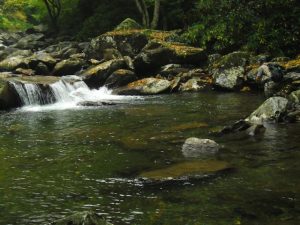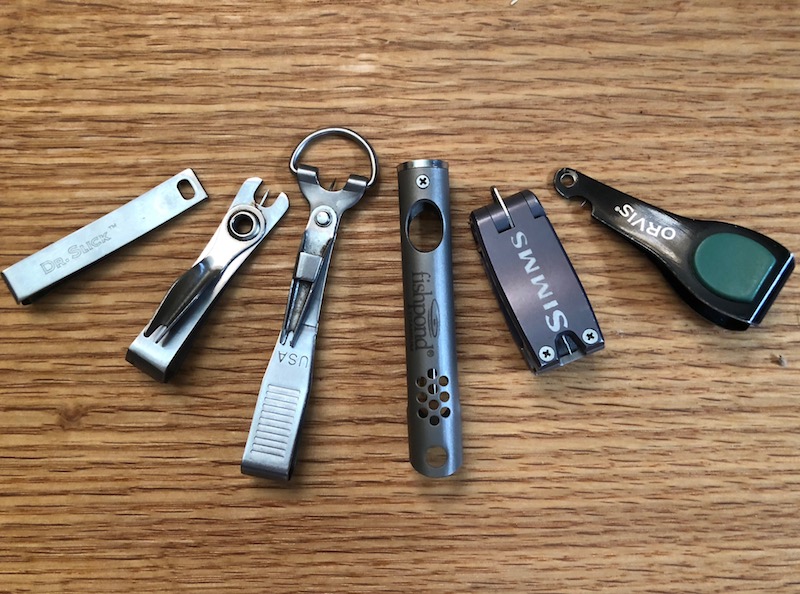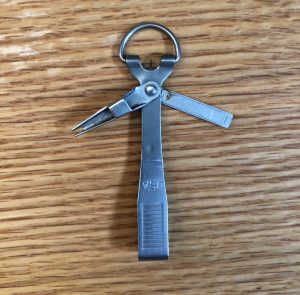One of the Easiest Ways to Catch More Trout in the Smokies….
I recently guided a husband and wife on a small brook trout stream in the Smokies. The stream, like most in the Smokies, consisted of a lot of pocket water, which meant getting closer to the fish. Both were novice fly fishers and their skills improved steadily as the day went on. As a matter of fact, their skills were about equal, but as the day progressed the wife was getting 5 or 6 strikes for every 1 strike the husband got.
We were moving up the stream together and they were taking turns fishing. They were fishing the same fly. And as mentioned before, their casting ability, approach, and presentation was nearly identical. What was different, you ask? The wife was wearing a drab green shirt and the husband’s shirt was bright red. Simple as that.

Casting can be challenging. Getting good drifts can be challenging. Figuring out what the fish are eating can be challenging. But dressing appropriately is one of the easiest things to control and can greatly improve your success on the stream.

Years ago, three seasoned fishermen from Montana walked into Little River Outfitters frustrated that they had fished two days without catching a fish. One was wearing a bright blue shirt, another was wearing a white shirt, and the other’s shirt was bright coral color. My good friend, Walter Babb, was sitting in the shop and without pulling any punches, said, “Well, those fish saw you guys get out of the car!”
When the fishermen pointed out that they wore the same clothing in Montana and caught plenty of fish, Walter went on to explain that in big western rivers, your background is the sky. Here it’s the trees and bushes.

You don’t have to be a fly fishing commando decked out in camouflage and twigs in your hat to catch fish in small mountain streams, but dressing in earth-tone colors does make a huge difference. Think drab greens, browns, tans, and greys when you dress for a day on the water. While bright white t-shirts and orange Tennessee ball caps may be appropriate for game day at Neyland Stadium, they are doing you no favors on the trout stream.
What about strike indicators? They’re bright and colorful. Don’t they spook fish? Sometimes they do, but usually for different reasons. It’s not really the bright color that spooks fish; it’s movement. These are wild trout in the Smokies and they’re right in the middle of the food chain. Any kind of movement, particularly above them, often means a kingfisher or heron is about to swoop down and eat them! The less you blend in to your background, the more pronounced your silhouette is, and the more noticeable your movements are.

All of this becomes more and more important the closer you have to get to the fish, even when you’re behind them. Trout actually have a “cone of vision” above them that even extends a little bit behind them. The closer you get and the higher up you are, the more you will be detected in that cone. So in addition to what you wear, think about how you move through the water to reduce the chances of spooking fish. Move slowly and quietly. Stay low, particularly when fishing in close quarters. See that big boulder in the stream? Don’t fish from on top of it. Stand behind it.
Finally, keep your false casting to a minimum. Fly lines are often brighter colors so that you can see them in order to mend and achieve good drifts. Remember, it’s not the color so much as the movement. Repeatedly false casting a fly line over a trout’s head is excessive movement in that cone of vision and will send him under a rock.


 As with most any fly fishing product these days, there are seemingly endless nipper styles and features to suit your needs and tastes. Some are just shaped differently, boasting a better ergonomic design. Others are equipped with additional tools for tasks such as tying knots or sharpening hooks. And if you want to take it to the next level, check out this description of Abel’s nippers:
As with most any fly fishing product these days, there are seemingly endless nipper styles and features to suit your needs and tastes. Some are just shaped differently, boasting a better ergonomic design. Others are equipped with additional tools for tasks such as tying knots or sharpening hooks. And if you want to take it to the next level, check out this description of Abel’s nippers: And they can be yours in black for a mere $85. For custom colors, they’re just $105. And with a cool fish print… a steal at $165. Yep, $165 for line cutters. All of a sudden, $10 for a pair of nippers doesn’t sound too bad, does it? As with anything else, if you have the disposable income and want to spend $165 of it on nippers, go ahead. I won’t judge you.
And they can be yours in black for a mere $85. For custom colors, they’re just $105. And with a cool fish print… a steal at $165. Yep, $165 for line cutters. All of a sudden, $10 for a pair of nippers doesn’t sound too bad, does it? As with anything else, if you have the disposable income and want to spend $165 of it on nippers, go ahead. I won’t judge you.